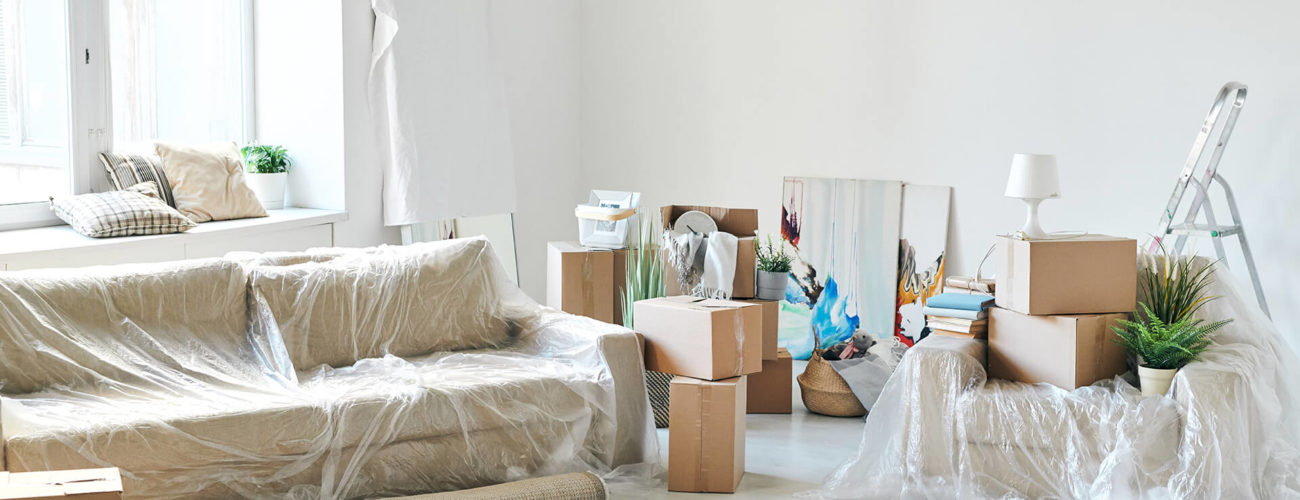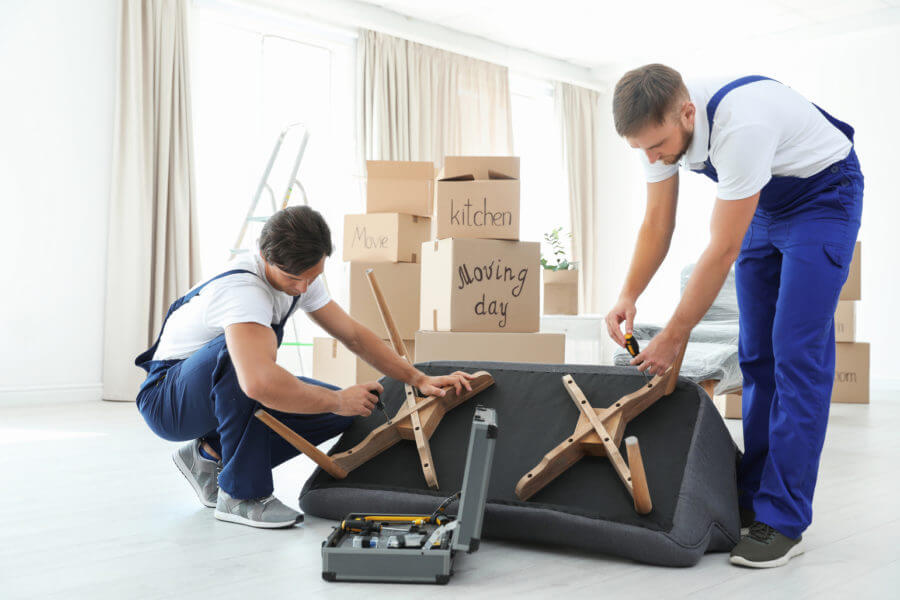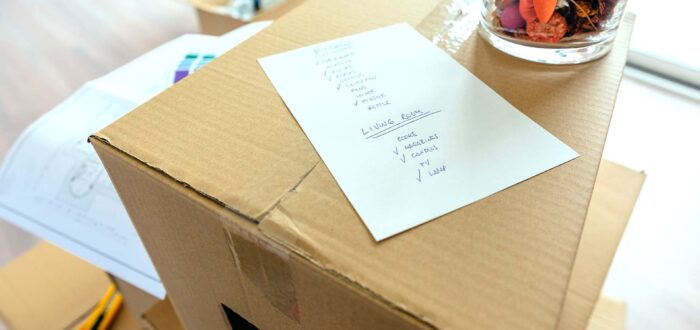

Best Way to Wrap Furniture for Moving Across the Country
Posted in Moving Tips & Tricks,Planning the Move on October 10, 2024
Couches, coffee tables, and other furnishings are not just items on the relocation checklist – they are precious cargo. That’s why many want to know the best way to wrap furniture for moving. After all, the right wrapping technique can mean the difference between a smooth relocation and a complete disaster. If you’re trying to figure out how to protect your furnishings from the perils of relocation, we have all the answers you seek.
What Is the Best Way to Wrap Furniture for Moving?
The optimal way of securing your precious furnishing is not simple, as it depends on several factors, like the type of furnishings, its material, the distance you’re moving, and how it will be transported. Different pieces require different methods to ensure they’re properly protected during the relocation. For example, delicate wooden pieces benefit from padding, while upholstered items need plastic wrap to shield them from dirt and moisture.
In general, though, here are a few key relocation tips:
- Take apart items like beds or tables, make them smaller and, therefore, easier to move and wrap,
- Use the appropriate material to protect the items from scratches, dents, and minor damage,
- Make sure all edges and delicate areas are cushioned, especially on fragile surfaces.
For those who don’t have the appropriate tools and materials, hiring long-distance movers is often the safest bet. Professional relocation crews know how to wrap and transport even the most demanding types of furnishings securely and efficiently.
Proper Wrapping Is the Key to a Smooth Interstate Move
Long-distance moving can be long and bumpy, but with the right protective measures, your beloved furnishing items will arrive at your new home without scratches and dents. Therefore, knowing the best wrapping techniques can save you money in the long run. Avoiding damage means fewer repairs or replacements, allowing you to allocate your relocation budget to more exciting aspects of your new life.
From using the right packing materials to mastering the art of securing the most fragile of your furnishings, proper preparation puts you in the driver’s seat of your move – making the transition as seamless as possible. By investing the time and care into wrapping your pieces correctly, you ensure that they arrive at your new destination in pristine condition and ready to be enjoyed.

Decluttering as an Essential Pre-packing Task
When moving across the country, decluttering becomes more than just tidying up. It’s about making informed decisions about what to keep and what to let go of. But why should you make it a part of your relocation day preparations?
First of all, keep in mind that the end price of a move increases with the weight and volume of your belongings – and furnishings are usually the biggest of the household goods. Decluttering allows you to save on relocation costs by reducing the number of items on your moving inventory. Not only that, but a smaller packing list means less material is needed, which simplifies the entire process.
All you have to do is determine which pieces of furniture and belongings are essential to your lifestyle and which items you can live without. It’s also beneficial if you can visualize how your new space will look and how your furnishings will fit – you’ll clearly see which pieces should be left behind.
If you’re not organizing a last-minute relocation, try to sell some of your furnishings and earn extra cash before the big day comes. You can also look at organizations such as Goodwill that will accept your donation and help someone enjoy items you no longer need.

Prepare the Items You’ve Decided to Keep
Cleaning the household goods is a step often overlooked during the relocation. However, furnishings can accumulate dirt, dust, and allergens over time. If left uncleaned, these particles can become embedded in the fabric or be pressed into wooden surfaces during the wrapping process.
Certain substances, such as food particles, spills, or oils, can leave stains that may worsen if the items are wrapped without cleaning. By thoroughly wiping down surfaces, you can remove these potential stains before they have a chance to set, preserving the furniture’s appearance and longevity. Not only that but dust and grime can make surfaces slippery and difficult to cover securely. Smooth and clean surfaces allow for the materials to adhere better, ensuring that everything stays in place during transport.
In the end, if you plan on using storage services for an extended period, cleaning it first helps ensure it remains in good condition. Dust and moisture can lead to mold or mildew growth if left on surfaces while in storage, which is certainly something you don’t want to deal with after the move.
Disassembling Is a Must
Preparation is all about simplifying the relocation process later on, and one of its most important parts is dismantling. First of all, dismantled furnishings take up less space, making it easier to maneuver through doorways, staircases, and tight corners. Not only that, but disassembling helps optimize space in the relocation truck, as well, allowing more efficient loading.
In addition to that, taking apart larger items reduces the risk of scratches, dents, or other damage. After all, fragile furniture pieces or delicate parts are less likely to break when detached and wrapped separately. Smaller, disassembled parts are also much easier to wrap securely with padding or protective materials.
In the end, heavy items can be difficult to carry, and disassembling them into smaller, more manageable parts is the best way to avoid injuries while relocating. Therefore, to make the whole relocation process easier for everyone involved, make sure disassembling becomes a high priority on your to-do list.

All Materials Needed for Securing Furniture
When organizing a move, having the right wrapping materials is one of those things that will ensure everything is transported in excellent condition. But what are these materials exactly? After all, packing fragile items cannot be the same as moving furniture. When you’re wondering how to wrap furnishings properly, know that you’ll need to get the following.
Moving Blankets
Moving blankets are thick, padded fabric coverings designed to protect furnishings during transport. They can easily cover larger items like sofas and dining tables, providing a cushioned barrier against bumps and scrapes that can occur in transit. Using these blankets not only safeguards your belongings but also prevents the transfer of dust and debris, keeping your items in pristine condition while they travel.
Plastic Wrap
A plastic wrap is an essential tool for securing furnishings together and providing an additional layer of protection. It’s particularly useful for wrapping upholstered pieces, as it can create a waterproof barrier against spills or moisture during transportation. Moreover, plastic wrap helps keep drawers and doors closed, preventing them from opening and risking damage. This versatile material is lightweight yet strong, making it an ideal choice for securing items quickly and efficiently.
Packing Tape
While it may seem simple, using high-quality packing tape ensures that seams remain closed during transit, preventing items from shifting out of their protective wrappings. With smaller pieces, packing tape can be used in conjunction with relocation blankets or bubble wrap to create a tight hold. Invest in a good dispenser for easy handling, and opt for wider tape to ensure maximum coverage and security.
Bubble Wrap
Bubble wrap is an excellent cushioning material for protecting fragile items or delicate furniture pieces, such as glass tabletops or decorative mirrors. This material adds an extra layer of shock absorption, reducing the risk of breakage during transportation. You can use it to cover individual items or fill gaps within boxes to prevent movement.
Foam Padding
Foam padding, on the other hand, comes in various forms, including sheets and corner protectors, and is particularly effective for safeguarding edges and corners. Together with bubble wrap, it provides comprehensive protection for your most vulnerable belongings.
Cardboard or Packing Paper
Use cardboard and packing paper when you need extra protection for fragile surfaces, like glass or mirrors, or to create cushioning between furniture pieces. Packing paper is ideal for wrapping smaller or delicate items, while cardboard sheets can add a sturdy layer to prevent scratches and dents on larger items.
Guide to Wrapping Different Types of Furniture
Different furnishing types have different vulnerabilities. For example, wooden pieces can scratch easily, while upholstered ones can get stained or torn. Knowing how to properly wrap each type ensures that your furnishings are completely shielded against scratches, dents, dust, moisture, and other potential damage during transportation or storage.
We’ve prepared some effective methods for wrapping various types of furnishings. They will allow you to protect your belongings to the fullest and enjoy a stress-free move – at least when it comes to relocating heavy items.
Securing Wooden and Upholstered Pieces
For wooden tables and dressers, start by covering the top surface with a moving blanket to prevent scratches. You can also use this material to cover the entire piece to ensure complete protection during transport. Secure it using packing tape, making sure that it’s snug but not too tight. For chair legs and edges of tables, apply bubble wrap to provide extra cushioning. Secure with tape, focusing on corners that are most likely to suffer damage.
When it comes to upholstered furnishings such as sofas or armchairs, cover them in full with a relocation blanket. Tuck it into the crevices to secure it tightly and use stretch wrap to hold everything in place. Wrap it around the item multiple times, ensuring everything stays secure. For added stability, especially with cross-country moving, use zip ties at the base and top to prevent the covers from slipping off.
Protecting Glass and Fragile Furnishings
When moving cross-country, glass and fragile items need special attention to prevent breakage. If you’re wrapping mirrors, cut two pieces of cardboard to the size of the mirror. Sandwich the mirror between the cardboard to create a protective sleeve. Once secured in cardboard, cover the entire mirror in bubble wrap for additional cushioning.
You can use the same technique for glass tabletops and shelves or cover them with blankets and secure them with packing tape. Be sure to protect the edges, as they are the most vulnerable. Always transport glass and mirrors in an upright position in the vehicle to prevent any undue pressure on the glass surfaces.
Dealing With Specialty Items
Specialty items can include anything from antiques and heirlooms to pianos and artwork. They need tailored wrapping techniques to ensure they arrive at your new destination in one piece. When packing antiques, for example, it’s best to use thick relocation blankets. Most of these items will also have carvings or intricate details – make sure to use bubble wrap to cushion these areas. In the end, add extra protection to sharp or delicate corners using corner guards or foam.
At the same time, keep in mind that art pieces are vulnerable to cracking or punctures. If you have some, you’ll need to cover the piece with packing paper or cardboard and then secure it with bubble wrap or blankets. Corner protectors are also advisable for additional support.

When Is the Right Time to Call Professionals?
If you think all this is too much work for you and you don’t have enough time or energy to secure the furnishings the right way, maybe you should consider cross-country moving services. Besides navigating the logistics, movers have the experience and training to pack furniture properly. They know the best methods to protect your items, whether it’s delicate antiques, bulky sofas, or fragile glass tables. Their expertise reduces the risk of damage during transport, especially for long-distance moves.
On top of that, some professionals, such as Cross Country Movers, will disassemble, wrap, pack, load, unload, and reassemble your furnishings at no additional cost. While you have the option to choose packing services for the rest of your belongings, you won’t have to pay extra for movers dealing with furnishing pieces.
Not only that, but professional movers will offer some form of relocation insurance, which can provide peace of mind. If any of your furniture gets damaged during the move, the policy you’ve chosen will ensure you get compensated. This level of protection isn’t available if you handle the packing and wrapping yourself.
Enhance Your Relocation Experience With Cross Country Movers
When hiring movers, you should look for a trusted partner that can make every aspect of your relocation flawless – and there is no one better for the job than Cross Country Movers. From the moment you begin packing to the final placement of the furniture in your new home, we ensure your prized possessions are handled with expert care.
Our experienced team specializes in wrapping, packing, and transporting even the most delicate and valuable items with precision. Let us take the complicated wrapping and heavy lifting off your hands. Contact us today, and get your free quote.





